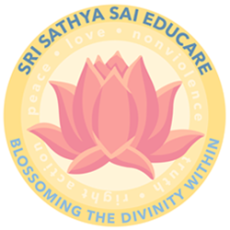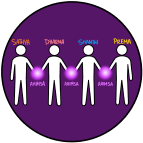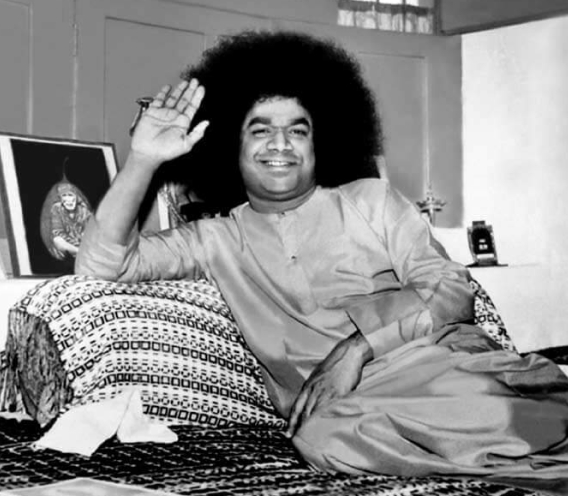
Sri Sathya Sai Educare
The program is available at Sri Sathya Sai Global Council Centers throughout the USA and is open to all children between the ages of 6-18 years old. This is a program created by Sri Sathya Sai Baba that acknowledges and is inclusive of everyone’s religion, culture, and ethnicity. Students are taught to love all and serve all, and to help ever and hurt never.

Sathya
Sathya
(Truth)
When Bhagawan Sri Sathya Sai Baba talks about Truth, He means something greater than what a dictionary might say. Webster’s dictionary defines it as: “The body of real facts or events.” Read below to see the spiritual definition, which is all-encompassing, as given by Bhagawan.
“Sathya (Truth) is that which must be said.”
(1995 Prasanthi Nilayam postcard)
“Truth is changeless, it is the same in the past, present, and future. Have faith that Truth exists thus and can be experienced.”
(November 22, 1981)
“What is meant when we say 'Truth is God'? Let a person be of any country or religion; truth is one. There cannot be American truth, Pakistan truth or Indian truth. Truth is truth. Truth is one and the same for all nations.”(January 13, 2003)
“The whole universe rests on the principle of truth. Truth is present everywhere. In fact, all affluence, comforts and conveniences follow truth. Without truth, there is no world at all. Truth is highly valuable. It cannot be hidden by anybody. It is unchangeable. Truth is changeless in all the three periods of time - past, present and future. Embodiments of love! Truth might be considered a simple word. But it is important to know the meaning of truth. Everything is contained within this truth. The whole world has this truth as the foundation. When the very foundation of truth is lost, what will happen to our life? There is no place without truth. Truth is all-pervasive.”
(August 30, 2001)
“Simply speaking the truth, or narrating facts as they are, is … truth of a much lower order: it is truth for that moment alone. The next moment it is no longer valid; it isn't the same as it was a little while before… All the material objects observable in this world are in continuous flux and change every moment, and they are all subject to decay. In this ever-changing and transient world, how can anything you see or hear be a valid and lasting truth? The real meaning of truth is GOD: Truth is the form of divinity… The spiritual truth of God is eternally valid, valid under any circumstances, and never changing, whether you use fire or whatever action you may take. Truth means that which is changeless, immutable, and remaining ever the same.That is truth; that is divinity.”
(The True Flowers for Worship (SSSBPT), p.16-17)

Dharma
Dharma
(Right Action)
Bhagawan often establishes that there is no English word for Dharma. Dharma is Dharma. In 1983, He simply defines it as that which does not come in the freedom of another person and often categorizes Dharma into individual dharma and atma dharma.
“Dharma is taken to be duty. This interpretation is not correct. This is only an English translation, rather inadequately expressed! The real interpretation of Dharma is Dharayati iti Dharma (that which sustains is Dharma). It sustains human life.”
(March 8, 2005)
“And, what is Dharma? Practising what you preach, doing as you say it has to be done, keeping precept and practice in line. Earn virtuously, yearn piously; live in the fear of God, live for reaching God—that is Dharma.”
(March 30, 1965)
“Practical dharma, or rules of good behaviour (achara-dharma), relates to temporary matters and problems and physical needs, to one’s passing relationships with the objective world. The very instrument of those rules, the human body, is itself not permanent, so how then can these dharmas be eternal? … In daily practice, when acts are motivated by the basic principle of the reality of the Atma, every act becomes stamped with the seal of dharma. But when acts are motivated by convenience and selfish interest, the dharma becomes pseudo-dharma.”
(Dharma Vahini, ch.2, p.13-16)
“Character, conduct, daily behaviour, attitude towards others—these are all-important, for Dharma (righteousness) is essentially Social Morality.”
(January 4, 1974)
“More than all, set right your habits, purify your conduct, and cleanse your behaviour.”
(September 2, 1958)
“The highest discipline is to bring about unity in thought, word, and deed.”
(February 7, 1980)
“If you seek to have the Lord on your side as your guide, equip yourself with divine nature, the qualities of Dharma. For the Lord is where Dharma is.”
(Gita Vahini, ch.1, p.9)
“The dharma of fire is heat and light. The dharma of ice is cold. The dharma of sugar is sweetness. In the same way, what is the dharma of humanity? It is sacrifice born out of truth and morality. How must it be practised and demonstrated? Through unity and purity in thought, word, and deed (trikarana suddhi). Human qualities flourish when the thoughts you entertain, the words you speak, and the deeds you do are in harmony.”
(Summer Showers in Brindavan, June 2, 1991)

Shanthi
Shanthi
(Peace)
We often think of peace as that which is found outside of us, especially in our families, communities and the larger world. Bhagawan flips that definition on its head and says that true peace is very individual/mind oriented.
“What exactly is Peace? It is the stage in which the senses are mastered and held in balance.”
(November 23, 1984)
"Today, in spite of all his wealth, man is unhappy. He is perpetually racked by lack of peace. Devotees come here from all parts of the world. Each of them asks: "I want peace." Here are three words: "I", "want", "peace". "I" is ego. "Want" is desire. Remove the ego and desire, you will have peace. Ego and desire have enveloped peace. When the covering is removed, peace will manifest itself." (June 3, 1995)
“Peace is essential for this sharpness of intellect. Haste and worry confuse the intelligence. Peace develops all the beneficial characteristics.”
(Prasanthi Vahini, p.13)
“Once you enter the depths of the sea, it is all calm, it is all peace; agitation, noise, confusion — all are only on the outer layers. So also in the innermost recesses of the heart, there is a reservoir of peace (shanthi) where you must take refuge.”
(September 27, 1960)

Prema
Prema
(Love)
This is the broadest definition yet of all the worldly definitions and misunderstandings of the word LOVE.
“The entire world is filled with love. The world is Love and Love is the world. Love is life and life is love… Love is an inborn quality in man. It is his lifebreath… Without it he ceases to be human.”
(December 25, 1993)
“Love is God, God is Love. Where there is Love, there God is certainly evident. Love more and more people, love them more and more intensely; transform the love into service, transform the service into worship; that is the highest sadhana.”
(March 26, 1965)
“The life of Sai, the Message of Sai, the ideals Sai holds forth, the lesson that Sai teaches the world, are all enshrined in one word, love.”
(November 19, 1980)
“Love expresses itself as Seva; Love grows through Seva; Love is born in the womb of Seva. And God is Love… It is the compassion of the Avatar prompts His every activity.”
(October 4, 1970)
“Spiritual love is boundless. It is free from the feeling of hatred. It is capable of expressing itself in universal terms.”
(December 25, 1997)
“The main quality of man is love. Love is God, live in love. Develop this principle of love today. You can give up anything but not love. Love is our very life force, love is our life, and love is the world, love is God.”
(February 16, 1996)

Ahimsa
Ahimsa
(Nonviolence)
Bhagawan often talks about Ahimsa as the underlying current among all the other human values.
“[Nonviolence] does not mean merely not injuring a living being. You should not cause hurt even by a word, a look, or a gesture.”
(February 7, 1980)
“Ahimsa shines as the undercurrent of the remaining four values, namely, truth, righteousness, love and peace. That which leads to violence cannot be truth, righteousness, love or peace.”
(September 26, 2000)
“So, be righteous; avoid all prejudices against others on the basis of caste, creed, colour, mode of worship, status, or degree of affluence. Do not look down on any one; look upon all as Divine as you really are.”
(January 13, 1970)
Sri Sathya Sai Baba's Educational Philosophy
Sri Sathya Sai Baba’s educational philosophy is holistic in that it fosters the inherent connection between science and spirituality, mind and heart, knowledge and wisdom, individual and society, and encompasses the entire life span from childhood to adulthood.
This educational philosophy is the perfect antidote to the gaps left in the current, secular education system. Challenging the current practice of education that focuses only on collection of facts and cramming of knowledge from the book to the head, this philosophy allows children to manifest their innate goodness, talent, skills, and excellence to benefit one’s home, community, nation, and world.

Guiding Principles of Educare
Divinity is love, and it is the undercurrent of all human values.
Educare elicits the inherent human values and translates them into action in daily life.
The purpose of education is for living a fully human and spiritual life.
The end of education is character and character manifests itself as the unity of thought, word, and deed
Program Genesis And Overview
During the formative period of the age group 6-18, it is easy to nurture and develop human values in children, and it is very natural for them to practice human values in their everyday life. Through the women’s wing (Mahila Vibhag) of the Sri Sathya Sai Seva Organisations, Baba started Bal Vihars in 1969. He laid down the purpose, scope, and goals of the Bal Vihar program that emphasized the inculcation of morality, ethics, and spirituality.
These cultural centers aimed at complementing school education with valuable spiritual classes based on the teachings of Bhagawan Sri Sathya Sai Baba. These classes were delivered every weekend. A national conference was organized in 1971 for volunteers who had been trained as teachers and administrators of the program. At the conference, the name ‘Balvikas’ was chosen to better clarify the objectives of the program. Balvikas is a Sanskrit term which means ‘blossoming of the child.’
The aim of the program is clearly defined as Vikas or Blossoming pertaining to one’s entire being.
-
Deha Vikas
(Physical Development or Blossoming of Body) -
Buddhi Vikas
(Development or Blossoming of Intellect) -
Atma Vikas
(Development or Blossoming of Spirit) -
Mano Vikas
(Mental Development or Blossoming of Mind) -
Bhava Vikas
(Development or Blossoming of qualities of Heart)
Timeline
Formation of Sri Sathya Sai Bal Vihar in Bombay.
First All India Bal Vihar Teachers' Conference held at Bombay.
'Bal Vihar' remaned as 'Balvikas'. Formal structure given to Balvikas with rules and regulations for conducting the classes. Balvikas Magazine commences
Second All India Conference for
Teachers conducted at Rajahmundry;
Three stage curriculum developed.
Third All India Conference held in Prasanthi Nilayam; Syllabus for Group III prepared; Balvikas introduced to other countries.
Fourth Conference organized in Prasanthi Nilayam; First All India Examination in Group III held; Introduction of ‘Diploma in Sathya Sai Education’.
Central Training Camp for Gurus at Brindavan, Bangalore.
Overseas Balvikas Gurus Conference held in Prasanthi Nilayam; Concept of Education in Human Values introduced.
Central Training of Overseas Balvikas Gurus and Group III Balvikas Gurus in Prasanthi Nilayam.
The program grew around the world and now is called Sri Sathya Sai Educare/Balvikas in USA
